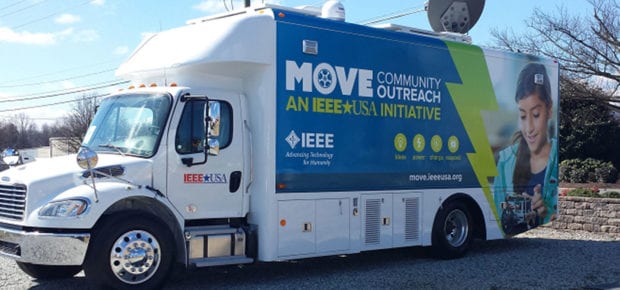July 5, 2017
Aligning with the vision of IEEE to advance technology for the benefit of humanity, The MOVE Project, sponsored by IEEE-USA, offers a mobile emergency relief program to assist victims of natural disasters. The MOVE truck provides temporary emergency provisions such as communication, computer, and power solutions. When it is not deployed for use in a disaster, the truck can provide mobile STEM education for communities. IEEE Transmitter caught up with IEEE-USA MOVE program director, Mary Ellen Randall, to learn more.
IEEE Transmitter: What is the history behind IEEE-USA MOVE?
Randall: MOVE was originally conceived as a way to engage members of IEEE in a meaningful way utilizing their specialized talents to help people after a natural disaster. Recent weather events, like Hurricane Katrina and Super storm Sandy, planted the idea that these are unique problems to be solved in a hurry. Who better to solve unique problems than engineers and technology professionals? It started with a small group of members who designed a unique communications truck, developed the program, obtained support, developed all the procedures, had the truck built and started operations.
Hoping that we would not always be attending to natural disasters, we needed an additional mission for the truck. Providing STEM education and showing students and the public the impact technology can have in such situations, was a natural extension to the original disaster mission.
IEEE Transmitter: When and how was the vehicle first utilized?
Randall: The first event was a STEM education event where we displayed the truck, along with other educators, and gave tours. Students, parents, and emergency responders went through the truck, while IEEE members proudly explained its technology features and intended use.
The first disaster relief response was the West Virginia flooding event in July 2016. We responded with our partner, the American Red Cross, and provided satellite internet, phones, power, and general technology support in setting up Red Cross operations.
IEEE Transmitter: How many vehicles are there now? Are there plans for more and in other places around the world? How do you see this project growing in the future?
Randall: Currently, there is one vehicle. We hope to build additional trucks tailored to other regions of the world. There are students currently working on a much smaller modular version, which may be useful on islands or may be more portable to access remote regions.
We have learned a tremendous amount from the six natural disasters we have responded to so far: two hurricanes (and resulting flooding), three large-scale flooding events, and one wild fire disaster.
IEEE Transmitter: What technologies are used in the vehicle and how does this help the affected people?
Randall: Every response situation is different. We have used the following capabilities in the truck at different times:
- We use internet access through satellite communications at nearly every response to help Red Cross relief workers, other agency relief workers, and the public via Wi-Fi.
- IP Phones that operate over our satellite link. These are especially useful in areas where the cellular and/or wired phone service is not available.
- On-board power (from solar panels and a diesel generator) to power not only our equipment, but to supplement building power when multiple agencies respond in a single location simultaneously to help those in need.
- MOVE can charge 120 cell phones or power banks (used to recharge cell phones) simultaneously. These are used by relief workers so they can operate their phones all day in areas where the cell signals are impaired by the disaster. They are also used to assist members of the public.
- Office space in the truck is used to provide a command center and to charge radios of first responders.
- The MOVE truck has been used to transport equipment (such as laptops, networking equipment, printers, satellite dishes, etc.) to set up new shelters, headquarters, and district offices which are near the worst hit areas.
IEEE Transmitter: Please explain the educational and other services the vehicle provides for communities when it is not deployed to help during natural disasters.
Randall: Home Fire Campaign – The Red Cross found that more people lose their lives in home fires than in natural disasters. They have a Home Fire Campaign program where hundreds of volunteers gather on a single day in a community to install smoke detectors in homes and apartments. MOVE serves as a command center for some of these events.
STEM education – MOVE has been to schools and public events such as the Atlanta Science Festival where we explain how all the equipment helps people in need. We also plan to be at the World Scout Jamboree in July, where tens of thousands of scouts, leaders and their families will learn about technology’s impact on our lives.
IEEE Transmitter: Can you provide an example(s) of the current and past emergency situations where the MOVE track and team provided assistance?
Randall: We have an extensive list here: IEEE-USA MOVE Community Outreach.
MOVE Community Outreach and its many volunteers have implemented and executed a great service to areas that need emergency relief, as well as bringing STEM education to people all across the country.




 Meaningful Momentum or Running in Place?
Meaningful Momentum or Running in Place? AI Through Our Ages
AI Through Our Ages Liquid Infrastructure: Our Planet's Most Precious Resource
Liquid Infrastructure: Our Planet's Most Precious Resource The Impact of Technology in 2025
The Impact of Technology in 2025 Quantum and AI: Safeguards or Threats to Cybersecurity?
Quantum and AI: Safeguards or Threats to Cybersecurity? Why AI Can't Live Without Us
Why AI Can't Live Without Us Bits, Bytes, Buildings and Bridges: Digital-Driven Infrastructure
Bits, Bytes, Buildings and Bridges: Digital-Driven Infrastructure Impact of Technology in 2024
Impact of Technology in 2024 Emerging AI Cybersecurity Challenges and Solutions
Emerging AI Cybersecurity Challenges and Solutions The Skies are Unlimited
The Skies are Unlimited Smart Cities 2030: How Tech is Reshaping Urbanscapes
Smart Cities 2030: How Tech is Reshaping Urbanscapes Impact of Technology 2023
Impact of Technology 2023 Cybersecurity for Life-Changing Innovations
Cybersecurity for Life-Changing Innovations Smarter Wearables Healthier Life
Smarter Wearables Healthier Life Infrastructure In Motion
Infrastructure In Motion The Impact of Tech in 2022 and Beyond
The Impact of Tech in 2022 and Beyond Cybersecurity, Technology and Protecting Our World
Cybersecurity, Technology and Protecting Our World How Technology Helps us Understand Our Health and Wellness
How Technology Helps us Understand Our Health and Wellness The Resilience of Humanity
The Resilience of Humanity Harnessing and Sustaining our Natural Resources
Harnessing and Sustaining our Natural Resources Creating Healthy Spaces Through Technology
Creating Healthy Spaces Through Technology Exceptional Infrastructure Challenges, Technology and Humanity
Exceptional Infrastructure Challenges, Technology and Humanity The Global Impact of IEEE's 802 Standards
The Global Impact of IEEE's 802 Standards Scenes of our Cyber Lives: The Security Threats and Technology Solutions Protecting Us
Scenes of our Cyber Lives: The Security Threats and Technology Solutions Protecting Us How Millennial Parents are Embracing Health and Wellness Technologies for Their Generation Alpha Kids
How Millennial Parents are Embracing Health and Wellness Technologies for Their Generation Alpha Kids Space Exploration, Technology and Our Lives
Space Exploration, Technology and Our Lives Global Innovation and the Environment
Global Innovation and the Environment How Technology, Privacy and Security are Changing Each Other (And Us)
How Technology, Privacy and Security are Changing Each Other (And Us) Find us in booth 31506, LVCC South Hall 3 and experience the Technology Moon Walk
Find us in booth 31506, LVCC South Hall 3 and experience the Technology Moon Walk Virtual and Mixed Reality
Virtual and Mixed Reality How Robots are Improving our Health
How Robots are Improving our Health IEEE Experts and the Robots They are Teaching
IEEE Experts and the Robots They are Teaching See how millennial parents around the world see AI impacting the lives of their tech-infused offspring
See how millennial parents around the world see AI impacting the lives of their tech-infused offspring Take the journey from farm to table and learn how IoT will help us reach the rising demand for food production
Take the journey from farm to table and learn how IoT will help us reach the rising demand for food production Watch technical experts discuss the latest cyber threats
Watch technical experts discuss the latest cyber threats Explore how researchers, teachers, explorers, healthcare and medical professionals use immersive technologies
Explore how researchers, teachers, explorers, healthcare and medical professionals use immersive technologies Follow the timeline to see how Generation AI will be impacted by technology
Follow the timeline to see how Generation AI will be impacted by technology Learn how your IoT data can be used by experiencing a day in a connected life
Learn how your IoT data can be used by experiencing a day in a connected life Listen to technical experts discuss the biggest security threats today
Listen to technical experts discuss the biggest security threats today See how tech has influenced and evolved with the Games
See how tech has influenced and evolved with the Games Enter our virtual home to explore the IoT (Internet of Things) technologies
Enter our virtual home to explore the IoT (Internet of Things) technologies Explore an interactive map showcasing exciting innovations in robotics
Explore an interactive map showcasing exciting innovations in robotics Interactively explore A.I. in recent Hollywood movies
Interactively explore A.I. in recent Hollywood movies Get immersed in technologies that will improve patients' lives
Get immersed in technologies that will improve patients' lives